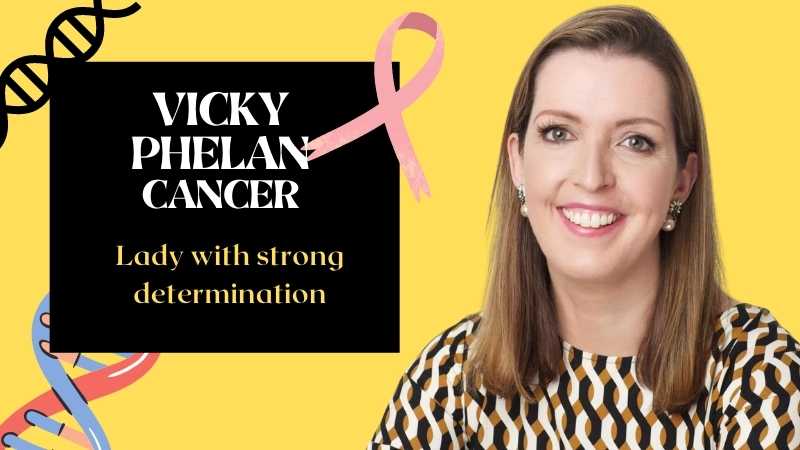Vicky Phelan is a cervical cancer awareness advocate and an avid CervicalCheck campaigner. She was diagnosed with terminal cancer in 2018 and often shares her journey as a cancer patient through her ups and downs.
On RTE’s Late Late Show, she shared what kept her going through all the tough times when she said, “I don’t want to die, I’m a young woman, I have young children, that’s what made me want to fight for them … You still want more, everyone wants more.”
Her bravery goes beyond just sharing her experiences. Her High Court action against the incorrect reading of her smear test brought the CervicalCheck scandal to the forefront.

It was later found that just like her, more than 100 women had faced a similar problem.
Ms Phelan further critiques our lack of knowledge regarding our bodies and the blind faith in the medical profession.
She says, “…we still look at doctors as if they are all-knowing, and that is not the case… There is a lot of stuff that goes on with women’s bodies, and it is embarrassing, but you have to be able to talk about them because otherwise, you end up in a situation like me … When you know your body, don’t be afraid to ask questions about it.”
Therefore, we must have some basic medical knowledge and awareness.
In this article, we will be doing so by elaborating on the case of Vicky Phelan, which cancer she has, her experiences, potential treatments and symptoms.
Vicky Phelan: Which cancer does she have, and how common is it?
Vicky Phelan, which cancer she has particularly, had been a question that had been central to the media for a long time. After the misguided results from the initial tests, she discovered that she had cervical cancer.
The vulva, vagina, womb, fallopian tubes, and ovaries form the female reproductive system. The cervix is the lower part of the uterus that connects to the vagina.
Cervical cancer happens when the cells in the cervix region change and get infected. These abnormal cells form a lining in the cervix that grows and develops into a tumour.
If this growth is not monitored and stopped at the initial stage, the cancer cells can spread to the other organs.
The cervix comprises of two parts, endocervix and ectocervix. The endocervix opens into the uterus above and the ectocervix is the lower opening into the vagina. The place where these two parts meet is called the transformation region.

The ectocervix cells are the skin-like cells that form the outer surface of the cervix. The most common type of cervical cancer happens when these cells become cancerous.
According to the World Health Organization (WHO), cervical cancer is the fourth most common cancer amongst women worldwide. A survey demonstrated that approximately 604000 new cases of cervical cancer were diagnosed globally in 2020 itself.
The same survey also recorded 342000 deaths due to cervical cancer in 2020, out of which 90% were from low- and middle-income countries.
In 2019, WHO also recorded 45300 deaths in India alone. Furthermore, the incidence rate for crude cervical cancer per 100000 women is 18.7 in 2020 in India.
The cumulative risk of cervical cancer in India in 2020 is 2 percent. Unfortunately, the mortality-to-incidence ratio happens to be 0.62. This ratio indicates deaths occurring per number of cervical cancer patients diagnosed.
The data makes us understand why the case of Vicky Phelan, which cancer she had, and the journey of her treatment is significant whilst discussing the importance of basic medical awareness.
Vicky Phelan: Which cancer did her symptoms demonstrate? What are the symptoms of cervical cancer?
Unfortunately, no extreme symptom can be traced in the early stages of the development of cervical cancer.
As cervical cancer reaches a more advanced stage, the following symptoms can be noted:
- Unusual vaginal bleeding may happen after intercourse, between menstruation or after menopause, or after a pelvic exam.
- Pelvic pain: It can be experienced at any time or during intercourse in the form of extreme pain
- Unusual vaginal discharge: One may note a bloody or watery vaginal discharge that may be heavy or have a foul odour
It is vital for you to remember that various other diseases also can cause similar symptoms.
To rule out cervical cancer, it is advised that you immediately consult a professional (General Practitioner) for a proper examination.

The consultancy may involve an examination of the vulva (or your vagina) with the help of a speculum a tool that helps doctors to directly look at the cervix) and a cervical smear, a gentle brush that collects cells from the cervix.
If the results of the above tests need further investigation, you may be asked to see a specialist for more detailed tests and examination.
Vicky Phelan: Which cancer did she have, and what were its causes?
Ms Phelan first went for a smear check for cervical cancer in 2011. Her results did not show any abnormalities, so it was unclear to Vicky Phelan which cancer she had. After several check-ups, she was diagnosed with cervical cancer in 2014.
Later in 2017, she found out that her original result was incorrect, and that had delayed her treatment and worsened her condition.
Cervical cancer happens when the healthy cells, mainly of the exocervix undergo mutations. Mutations are genetic changes which disrupt the normal processes of the cell. Normally, cells grow multiply and die at a certain rate.
Due to mutations, the cells can multiply faster, and their dying process gets disrupted, thus causing an imbalance. This imbalance leads to unwanted increased growth of cells.
In short, the new cells keep on growing before the old ones can die. It is this excess of cells that causes the tumour to grow.
Anyone with a cervix (women, trans men, non-binary people, and intersex people) are can get cervical cancer. However, it is not possible to develop this cancer if the womb or the cervix has already been surgically removed as can happen due to various reasons.
While no specific cause can be detected, a certain correlation has been established between human papillomavirus (HPV) and cervical cancer.
HPV is a common virus; it can be transmitted through:
- Any skin-to-skin contact of the genital area
- Sharing of sex toys Vaginal, oral or anal sex
This does not imply that everyone with HPV will develop cancer In addition to HPV, there are certain environmental and lifestyle factors that can contribute towards getting cervical cancer . These factors include:
Being under 45: This type of cancer is more common among younger people.
- Weakened Immune System: A weak immune system (for instance, due to HIV or AIDS) makes a person more prone to the development of cervical cancer.
- Medical History: If the person has been a prior patient of cancer (vaginal, vulval, kidney or bladder), then it increases the risk of cancer reappearing.
- If a person has birthed multiple children or had them at an early age (under 17), it makes them more vulnerable to the chances of cervical cancer.
- Diethylstilbestrol (DES): This is a hormonal medicine. It is noted that if this medicine is consumed by your mother while pregnant with you, it might increase your risk of cancer.
Centre for Disease Control and Prevention, (US body), estimates that over half of the sexually active population will be carrying this virus at some point in their lives, but only some women develop cervical cancer.
According to WHO, women with HIV are six times more likely to get cervical cancer.
Cervical cancer often develops at a slow and gradual pace. The data estimates that the virus takes over 15-20 years to develop into cancer for women with a standard immune system and 5-10 years for women with a weakened one.
Vicky Phelan: Which cancer is easier to detect? How is cervical cancer detected?
Detecting cancer at the earliest possible stage is one of the biggest challenges of medicine. Depending on the type of cancer, the tests for each of them are different. Melanoma, the skin cancer, is one the easiest tosuspect due to its visible symptoms. Early detection of the cancer also leads to a high survival rate.
If the results would have been accurate, early detection would’ve told Vicky Phelan which cancer she had, and her treatment could’ve been prompt This would have increased her chances of survival and improved her quality of life.
The most common and effective method to detect cervical cancer is through screening. It is advised that women have regular screening check-ups starting from the age of 21. In the UK all eligible people receive a screening invitation every 3 years between ages 25-49, and every 5 years between ages 50-65.
The screening tests looks for :
- HPV in the cervical cells
- If no virus is found, the person is re-invited 3-5 years later depending on their age.
- If the virus is found but no abnormal cells have been found, a repeat test is done after 12 months to check if the virus has been cleared off by the immune system and that the cells are no more abnormal.
- If abnormal cells are detected, further specialised tests are done to rule out any cancer transformation in these cells.
It is important to keep in mind that screening tests are not diagnostic. It cannot tell you for sure if you have cervical cancer. If abnormalities are noted during the screening, then it is advised that you proceed further with specialised tests under your doctor’s guidance.
Vicky Phelan: Which cancer is she battling, and what are the potential treatments?
The question was finally answered for Vicky Phelan, which cancer she had when she was diagnosed with cervical cancer in 2014. She then went on to receive a range of treatments to help her fight this disease.
The decision on the details of treatment depends on various factors.
These factors include:
- Type of cervical cancer
- Size of growth
- Location of the cancer
- How far it has spread
Any past medical conditions and the general health
The treatment usually includes surgery, radiotherapy or chemotherapy. Sometimes to aid the treatment procedure, targeted medicines are also included.
Surgery is the central part of the treatment, particularly in cases of early detection. The surgery varies according to the type and growth of the cervix cancer.
For instance, if the cancer is detected in an earlier stage with a smaller size, only a part of the cervix needs to be removed via surgery.
But in some cases, the patient has a previous history of similar cancer and no other treatment is possible. In such cases, several parts (such as the cervix, womb, ovaries and fallopian tubes, and all or parts of the bladder, bowel, vagina or rectum) ought to be removed.
Chemotherapy kills cancer cells through medicines. This is usually undertaken to:
Decrease the cancer cells before surgery
- After radiotherapy or/and surgery to stop cancer from coming back
- If cancer returns or has spread to other parts of the body
Radiotherapy kills cancer cells through high-energy rays. This is usually undertaken as:
- The primary treatment: In cases when cancer has grown large or has spread a lot
- Prevention after the surgery: It is used along with chemotherapy to reduce the chances of cancer coming back.
Vicky Phelan: Which cancer did she have, and how can it be prevented?
Before you read further, it is critical to understand that cervical cancer is not always preventable, but adequate knowledge of risk factors and red flags can help us improve our chances of early detection and hence possible cure.
If it had been known in time to Vicky Phelan, which cancer she had, her survival chances would’ve been higher.
The two most effective means to prevent cervical cancer are cervical screening and HPV vaccination.

WHO points out the disparity between the rate of cervical cancer in high-income and low-income nations. The former has fewer cases because it holds regular programmes for vaccination against HPV, screening and treatment. E.g. in the UK, the cervical screening coverage for 2019-20 was 72%, which however was lower than the efficacy standard of 75% coverage.
Screening increases the chances of being able to locate pre-cancerous cells before they spread further.
HPV vaccination for children aged 12 to 13 protects against any cancer that might be caused by HPV and prevents genital warts.
Other lifestyle changes that can aid in the prevention of cervical cancer are:
Safe intercourse: Using protection through condoms can lower your risk of HPV transmission. Though it is not an entirely effective measure, it does not prevent skin-to-skin contact in genital areas.
- Quit Smoking: Smoking lowers the strength of your immune system. The chemicals in cigarettes are said to aid in the development of cervical cancer.
- Balanced Diet: Strengthening and maintaining your immune system is extremely crucial in preventing cancer.
What is HPV Vaccine, and is it effective?
Before we address the question of vaccines, let us understand some things regarding HPV.
HPV refers to a group of common viruses and has over 100 types. Some of these viruses are called ‘high risk’ because they are linked with cancer.
For instance, 99% of patients with cervical cancer have HPV. HPV are also associated with the development of anal cancer, genital cancer, conditions like warts, and cancer of the head and neck.
The NHS, UK programme provides a two-dose vaccination against HPV, which is deemed a necessary preventive measure for cervical cancer.
The programme provides vaccination for kids aged 12 to 13 and offers free vaccination for anyone below 25.
According to studies by the NHS, vaccination prevents the growth of HPV for over ten years. However, women over 25 are advised to have regular cervical screening tests as a further preventive method.
Vicky Phelan: Which cancer has the least survival rate? What are the chances of survival of patients diagnosed with cervical cancer?
The survival rate of patients varies due to multiple factors, including which type of cancer they have and what stage they are on. According to Cancer Research UK, the rate ranges from 98% for testicular cancer to 1% for some pancreatic cancer.
Considering the case of Vicky Phelan, she said, “Four weeks ago I didn’t think I’d see Christmas, that’s how real this is for me … At this stage, I’ve been fighting this terminal part of the disease since 2018.”
- A study by Cancer Research UK noted England’s general estimated survival rate. The study demonstrated:
- More than 80% of cervical cancer patients will survive over a year and more after diagnosis
- More than 60% of cervical cancer patients will survive over five years and more after diagnosis
- More than 50% of cervical cancer patients will survive over ten years and more after diagnosis
Please note that one-year or five-year survival does not mean that your condition would worsen after the period. It merely shows the years you’ve survived with cancer.
Vicky Phelan had recently posted about the progress in her health. She said, “Two weeks ago, I honestly thought it would never happen, but the human body and the human spirit are AMAZING things.”
Vicky Phelan: Which cancer affects her, and how does she cope? What is life like with cervical cancer?
After her diagnosis with cervical cancer in 2014, her journey has been full of ups and downs.
Last month in March 2022, Vicky Phelan took a break from social media to spend time with her family. She had said, “I hope that people understand. Unfortunately, my condition has become unpredictable and is impacting more and more on my everyday life.”
Even after the treatment, women who have survived cervical cancer are often plagued with the thought of cancer coming back.
Right after the diagnosis, each facet of the patient’s life goes through a change. During these changing and challenging times, here are some strategies which can help you cope:
- Medical Support: Before anything, be sure that you have a medical support system consisting of professionals and your loved ones.
- Know Better: To cope and treat yourself better, learn more about your condition. Please do so by asking questions to medical health professionals that you are consulting. You can even ask someone to accompany you, as it may be a lot of information to remember at once.
- Practical Support: In case you are struggling with the treatment expenses, try to consult your doctor or specialist nurse regarding this. Talking it out and asking for help initially can avoid a problem for later and also decrease your stress level.
- Support System: It is always better to talk to someone to help you with the onslaught of mixed emotions. By talking to someone, you are sharing your burden and organising your thoughts in a better manner.
Throughout this entire journey, resilience often becomes the key. Taking a break and focusing on your mental health is equally essential as focusing on your physical health.
Sometimes, it did not matter to Vicky Phelan which cancer she struggled with, but what she faced during the struggle.
She talks about her experiences of resilience and rediscovery of self when she says, “But making plans and having something to look forward to is so important because it gets you out of the bed in the morning and gives your life purpose…make(s) me remember me, the Vicky before cancer who loved nothing more than going out with her friends, to listen to live music.”
You may also like,






